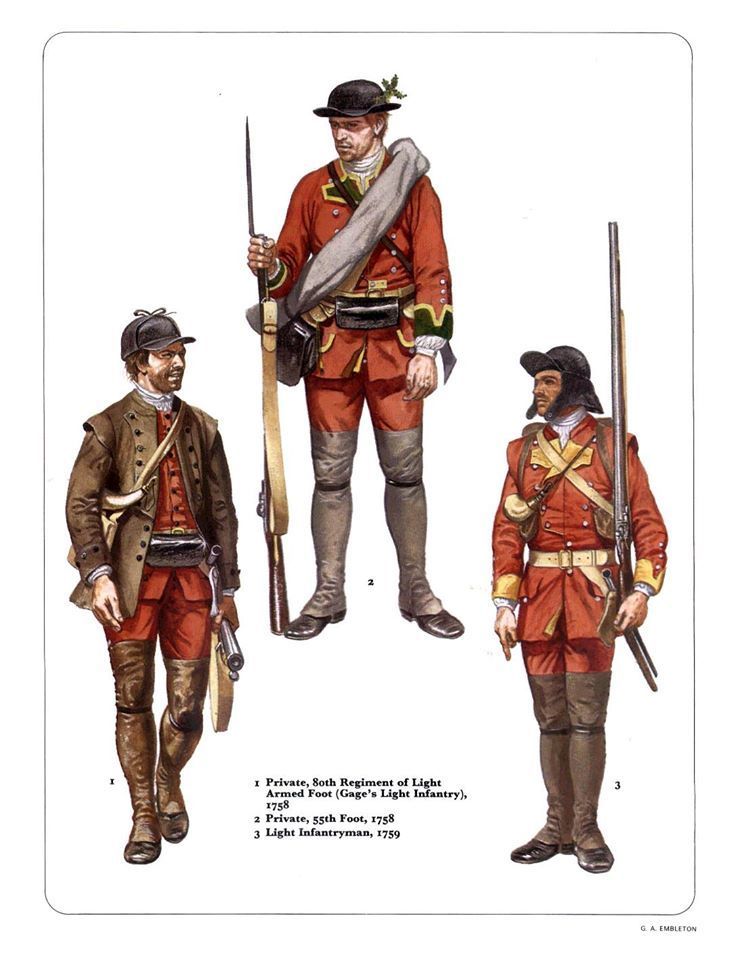
‘Light troops are, as it were, a light or beacon for the general, which should constantly inform him of the situation, the movements and nature of the enemy’s designs; it is upon the exactness and intelligence of what they report that he is enabled to regulate the time and manner of executing his own enterprises.’ (Colonel Coote Manningham)
There was nothing particularly new about light infantry at the turn of the nineteenth century. Most armies had light troops in some form, including the British who had theoretically deployed light companies of just forty-four men since the middle of the eighteenth century. Captain Cooper wrote in his 1806 compendium of works on light infantry that
In the American wars they were particularly useful; and the mode of fighting, which the American nations pursued, evidently showed the necessity of such a corps. For, until Light Infantry were established, a regular army was never safe on its march, being always harassed and dispirited by the irregular troops of the enemy. To obviate these difficulties, the British Generals selected the most enterprising officers, and the most active of the privates … by these means they produced the desired effect; they engaged the enemy in his own way, opposed Light Troops to Light Troops, repulsed him with advantage, and secured and facilitated the operations of the army. The success of these troops gave rise to the formation of a Light Company in every regiment.
After the peace of 1763, the Light Companies were all reduced.
Notwithstanding the above, in the British military tradition the army mainly relied on foreign mercenaries and locally-raised irregulars when light troops were needed. The majority of the light infantry fighting for the British in the forests of North America were provided by the likes of Rogers’ Rangers. Armed with, for instance, the Pennsylvania long rifle or the Ferguson rifle, they were a very effective supplement to the red-coated British infantry in the heavily-wooded terrain of the colonies. During the American War of Independence, Hessian mercenaries provided most of the formal light infantry presence in the order of battle.
At the end of the wars in North America the conservative military view was that formed units of light infantry would be of little utility on the more open European battlefield and that the practice of raising companies of backwoodsmen or hiring mercenaries when the situation dictated would suffice.
In Dundas’ drill manual of 1792 which consists of 458 pages, only 11 appertained to light companies. All this is not to say that there were not advocates of light infantry, but those that developed and practised light tactics tended to do so well out of the gaze of the Horse Guards.3 The fact that the term ‘Light Bob’, which later became a plaudit, was almost an insult before and during much of the French Revolutionary Wars is a measure of how far the British military were from accepting whole light infantry units into the regular army on a permanent basis.
The process of change in the outdated British military came as a result of the hard school of defeat in early campaigns and battles against the French revolutionary armies between 1792 and the end of the century. The raw energy released by the Revolution and the levée en masse had produced large numbers of enthusiastic but barely-trained soldiers. In battle they attacked in columns preceded by clouds of voltigeurs and tirailleurs deployed as a protective skirmish screen, which also galled the enemy line with their fire. This was so effective that by the time the column closed, the enemy was half defeated.
Volley fire against skirmishers was ineffective; they would either go to ground or into cover as the orders ‘Ready, present, fire’ were given, and similarly a bayonet charge had little effect against tirailleurs who simply fell back and resumed their firing as the line re-formed. In short, without sufficient skirmishers of their own to counter those of the French, the British could do little to oppose the voltigeurs. Slowly an understanding of the need for more than a nominal light company per infantry battalion grew, but there was continued opposition from the ranks of more conservative officers. Nonetheless, in 1794 Thomas Graham (later major general) was authorized to raise the 90th Regiment as light infantry following the experience of facing tirailleurs the previous year.
By the final years of the eighteenth century there were senior commanders such as Generals Grey and Sir John Moore, both veterans of North America, who were active exponents of light infantry. Sir John had witnessed the methods of one of his commanding officers, Lieutenant Colonel Mackenzie. Following this seminal moment Sir John started to form his own theories, based on his experience of campaigning in the Mediterranean and the West Indies, which he put into practice when he held a command during the United Irishmen’s rebellion in 1798. He trained elements of his force, including a militia battalion, as light infantrymen or, as he promoted the concept, as ‘a universal soldier’. This was an infantryman that was, he stressed, not only trained to fight conventionally in line but also capable of being deployed as a skirmisher. The writings and advocacy on light infantry that had been begun by a handful of almost visionaries in the last decade of the eighteenth century had, by 1806, had become a deluge of print, including compendiums such as Cooper’s bringing together the best thought and practice regarding light troops.
Despite growing enthusiasm, the conversion of whole battalions to light infantry would, however, not begin until 1803. In the meantime, the appreciation and tactical handling of line battalions’ light companies was improving rapidly.